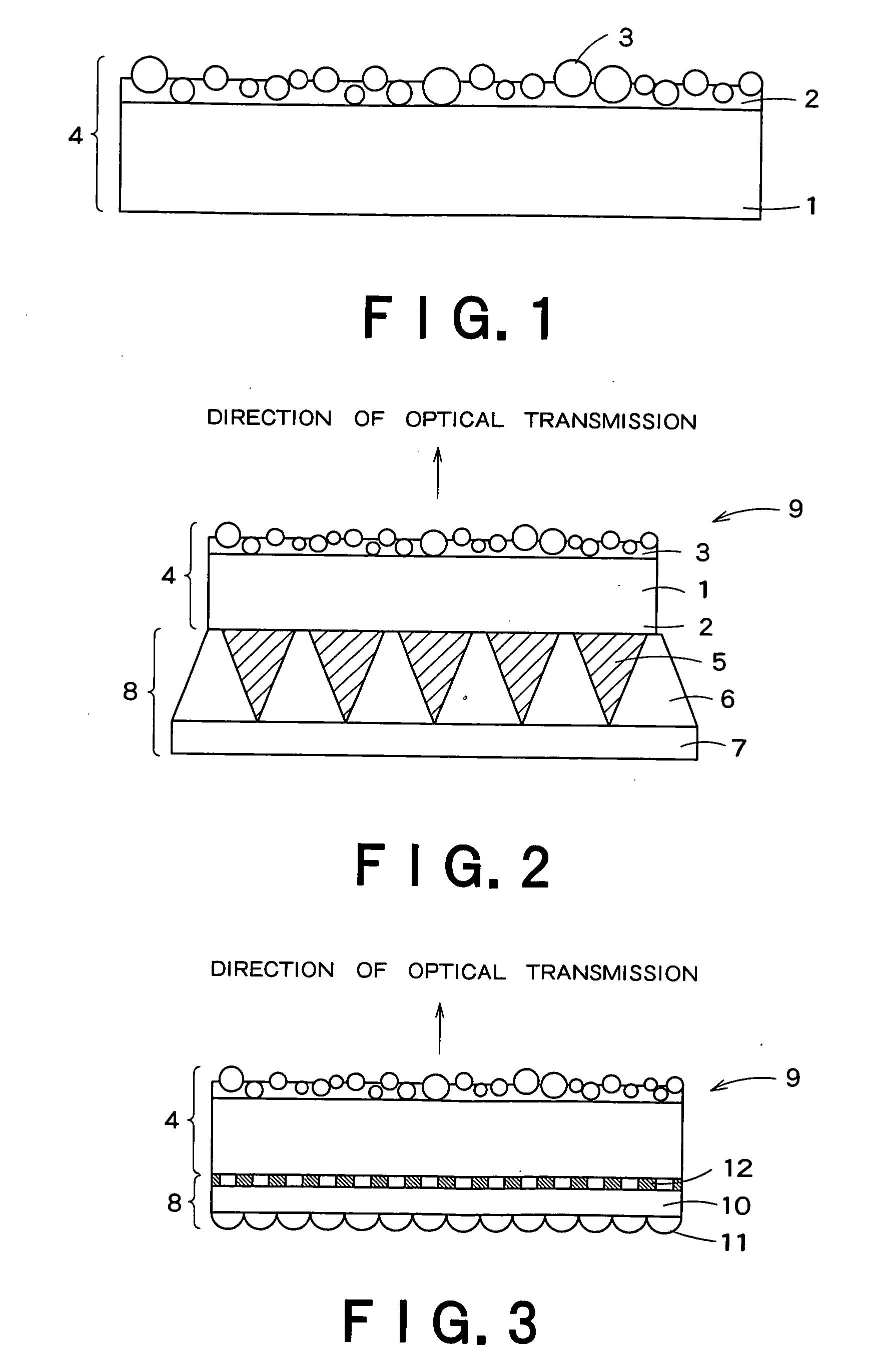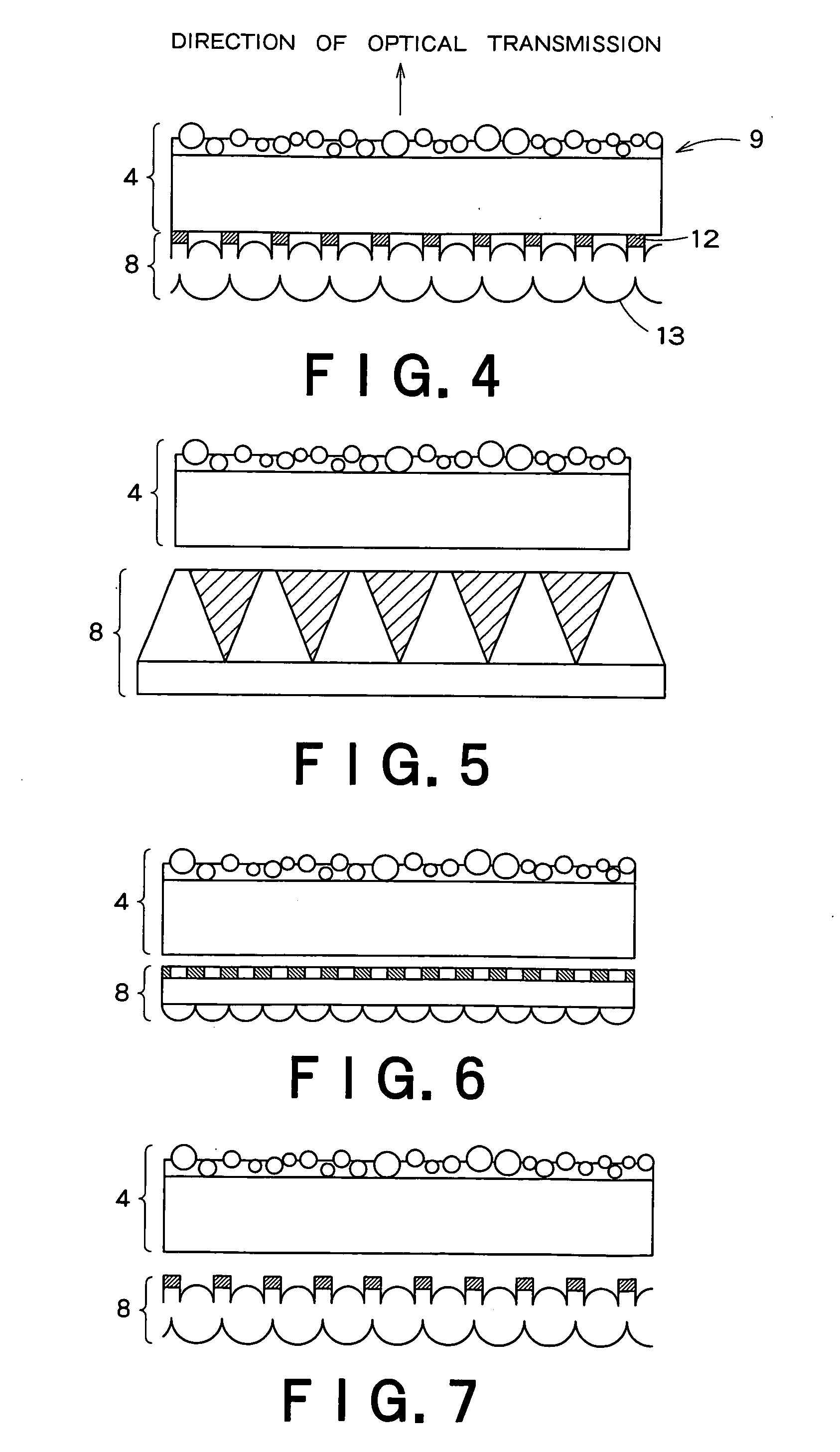Surface protective member for transmission screen
- Summary
- Abstract
- Description
- Claims
- Application Information
AI Technical Summary
Benefits of technology
Problems solved by technology
Method used
Image
Examples
production example 1
[0046] Five types of resin beads having average particle diameters of 3 μm, 5 μm, 10 μm, 15 μm, and 18 μm were used. All of these resin beads were of a monodisperse type and had a standard deviation of 3 μm. The resin beads were mixed in the ultraviolet curing resin composition to a concentration of 3% by weight to prepare coating liquids.
[0047] Each of the coating liquids was then dip coated onto the transparent substrate. The coating was irradiated with ultraviolet light to cure the resin composition and thus to form a hard coat layer on the transparent substrate. Thus, a surface protective member was prepared. The thickness of the hard coat layer was regulated by regulating the speed of pulling up the transparent substrate from the coating liquid in the formation of the hard coat layer by dip coating. Surface protective members were prepared in the same manner as described above, except that the thickness of the hard coat layer was varied.
[0048] The thickness of the hard coat l...
production example 2
[0049] Resin beads, which were of a monodisperse type and had an average particle diameter of 10 μm and a standard deviation of 3 μm, were used. The resin beads were mixed in the ultraviolet curing resin composition to the content (% by weight) specified in Table 2 below to prepare coating liquids.
[0050] Each of the coating liquids was then dip coated onto the transparent substrate. The coating was irradiated with ultraviolet light to cure the resin composition and thus to form a hard coat layer on the transparent substrate. In this case, the thickness of the hard coat layer was regulated to 10 μm by regulating the speed of pulling up the transparent substrate from the coating liquid. Thus, surface protective members with varied resin bead contents were prepared.
[0051] The thickness of the hard coat layer, and the average particle diameter, content and standard deviation of the resin beads used were as specified in Table 2.
TABLE 2AverageparticleThicknessdiameter ofStandardConten...
production example 3
[0052] Two types of resin beads with varied standard deviations were provided. Both the resin beads had an average particle diameter of 10 μm. The resin beads were mixed in the ultraviolet curing resin composition to a concentration of 3% by weight to prepare coating liquids. Each of the coating liquids was coated onto the transparent substrate in the same manner as in Production Example 2 to form a hard coat layer. In the same manner as in Production Example 2, the thickness of the hard coat layer was regulated to 10 μm. Thus, surface protective members with varied resin bead contents were prepared.
[0053] The thickness of the hard coat layer, and the average particle diameter, content and standard deviation of the resin beads used were as specified in Table 3.
TABLE 3AverageparticleContent ofdiameter ofStandardresinThickness ofProductionresin beads,deviation ofbeads,hard coat layer,Example 3μmresin beads, μmwt %μmC1103310C2106310
[0054] The surface gloss of hard coat layer was the...
PUM
| Property | Measurement | Unit |
|---|---|---|
| Length | aaaaa | aaaaa |
| Percent by mass | aaaaa | aaaaa |
| Angle | aaaaa | aaaaa |
Abstract
Description
Claims
Application Information
 Login to View More
Login to View More - R&D
- Intellectual Property
- Life Sciences
- Materials
- Tech Scout
- Unparalleled Data Quality
- Higher Quality Content
- 60% Fewer Hallucinations
Browse by: Latest US Patents, China's latest patents, Technical Efficacy Thesaurus, Application Domain, Technology Topic, Popular Technical Reports.
© 2025 PatSnap. All rights reserved.Legal|Privacy policy|Modern Slavery Act Transparency Statement|Sitemap|About US| Contact US: help@patsnap.com



